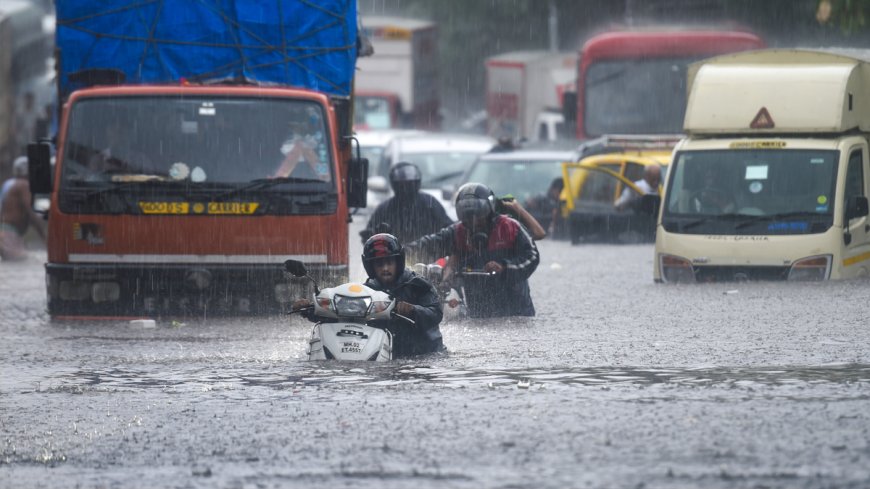Mumbai and Southern States Reel Under Monsoon Fury: Cities Paralyzed Amid Red Alerts
Mumbai and parts of South India face monsoon chaos with red alerts, heavy rainfall, and urban flooding. Read expert insights, government updates, and safety measures.

As the southwest monsoon arrives earlier than expected, Mumbai and several southern states have been hit hard with relentless downpours, flooding, and red alerts. Roads are submerged, rail services disrupted, and residents are grappling with waterlogged streets and power outages. The India Meteorological Department (IMD) has issued red alerts in multiple regions, urging people to stay indoors and avoid non-essential travel.
Monsoon Chaos in Mumbai: A City Brought to Its Knees
On May 27, 2025, Mumbai recorded over 200 mm of rainfall in a matter of hours, disrupting life in key zones like Andheri, Dadar, and Kurla. Several local trains were delayed or canceled, and Mumbai airport operations were temporarily suspended due to poor visibility.
According to the IMD's official report, more than four districts in Maharashtra, including Mumbai, Thane, Raigad, and Palghar, are under red alert. Flooded subways, traffic snarls, and rising water levels in the Mithi River have pushed civic authorities into emergency response mode.
The Brihanmumbai Municipal Corporation (BMC), while attempting to drain excess water, has urged residents to follow updates on the BMC Disaster Management Portal and avoid stepping out unless absolutely necessary.
Southern States Hit Hard: Kerala, Karnataka, and Tamil Nadu Battle Deluge
While Maharashtra faces an urban flooding crisis, Kerala, Karnataka, and parts of Tamil Nadu are experiencing their own climate emergencies. Heavy rains have triggered landslides in Idukki and Wayanad, leaving dozens of families displaced. The Kerala State Disaster Management Authority (KSDMA) has issued alerts for hilly areas and advised evacuation in landslide-prone zones (KSDMA official site).
In Bengaluru, traffic crawled through waterlogged roads as heavy showers continued for the second consecutive day. With stormwater drains overflowing, several neighborhoods such as Whitefield and Koramangala witnessed knee-deep water, prompting intervention from the BBMP Emergency Task Force.
Red Alerts and Emergency Response
The IMD red alert indicates “exceptionally heavy rainfall” with potential for flash floods, landslides, and severe disruptions in daily life. Emergency services across states have been mobilized, with the National Disaster Response Force (NDRF) teams deployed in affected districts.
For real-time weather updates and regional alerts, citizens are encouraged to track advisories via the IMD Weather App and official disaster helplines.
Climate Crisis: Experts Warn of Increased Frequency
Environmental researchers from TERI - The Energy and Resources Institute have emphasized that the early and intense onset of monsoon in 2025 is a stark reminder of climate change and its impact on extreme weather patterns. They point out that global warming is leading to erratic rainfall distribution and increased frequency of urban flooding.
In a recent statement, TERI warned that without long-term urban resilience planning, metros like Mumbai and Bengaluru will continue to remain vulnerable.
Infrastructure and Urban Planning Challenges
Mumbai’s aging drainage infrastructure, despite being under constant upgrades, has once again failed to cope with the monsoon surge. Experts at the National Institute of Urban Affairs (NIUA) have long advocated for a comprehensive drainage overhaul and climate-resilient urban planning to prevent such yearly monsoon disasters.
Similarly, the Smart City initiatives across southern states must prioritize stormwater management and flood resilience in their ongoing development plans, say urban planners.
Government Measures and Public Advisories
-
Maharashtra CM Eknath Shinde chaired an emergency meeting to monitor the situation and ordered round-the-clock helplines.
-
Schools and colleges in the worst-hit areas have been shut temporarily.
-
The Southern Railway has canceled or rescheduled multiple trains to and from Chennai, Kochi, and Bengaluru.
-
NDMA (National Disaster Management Authority) has recommended carrying emergency kits, avoiding underpasses, and staying away from swollen rivers.
How You Can Stay Safe
Authorities recommend the following during red alerts:
-
Stay indoors during heavy rainfall.
-
Avoid travel through flooded areas.
-
Monitor updates from IMD, state disaster portals, and local news agencies.
-
Keep emergency supplies, drinking water, and power backups ready.
Conclusion
The early monsoon downpour in Mumbai and the southern states has exposed systemic vulnerabilities in urban infrastructure and emergency preparedness. While relief efforts are underway, experts underscore the urgent need for climate-adaptive planning and citizen awareness to mitigate the risks of future deluges.
Stay connected to NDTV Weather and Hindustan Times Monsoon Tracker for continuous updates.



















































